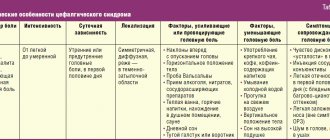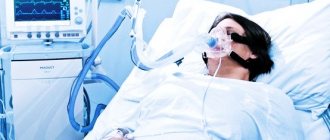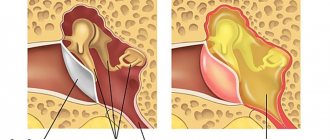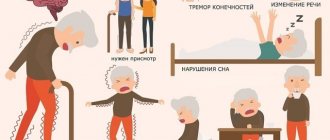Stunned or lethargic
When faced with dazedness or inhibition, patients react poorly to their environment and speech, and they become indifferent to everything they see, hear and feel. If the disease worsens, simple stupor can turn into a coma
, that is, a complete “turn off” of consciousness. After exiting this state, the patient will remember absolutely nothing about what happened. The patient may fall into a coma if he has diabetes, kidney or liver failure, as well as some other diseases.
Delirium (hallucinations)
This syndrome means that the patient may experience various kinds of hallucinations - deceptions of the senses and perception. For example, a person may hear voices that are not there or see something that does not exist. At the same time, the patient is completely confident that everything is happening for real, and cannot distinguish reality from illusion. In this regard, the patient may experience severe behavioral deviations. They can manifest themselves in both positive and negative emotions, depending on the nature of the hallucinations.
For this reason, the patient can be dangerous both to himself and to others and society in the broad sense of the word. When “returning to reality,” the memory of hallucinations is preserved, but the memory of reality is most often not. This symptom often manifests itself in severe poisoning and infectious diseases.
Associated disorders
Bradypsychia is the result of damage to the central nervous system, which is responsible for brain activity. Depending on the element of the lesion, different types of disorders develop. These include:
- bradybasia - slow walking;
Bradykinesia is characteristic of parkinsonism - bradythymia - slow changes in emotions;
- bradykinesia - slow pace and limited range of movements;
- bradypraxia - slow direction of action;
- Bradylexia – slow reading;
- bradyphasia, bradyllalia is a slowdown in speech, at the same time it is almost always correct, observed both in adulthood and in childhood (bradylalia is often observed in patients recovering);
- Impaired articulation may also develop, and during a long conversation the person may become tired.
When bradypsychia is a consequence of Parkinson's disease, it is necessary to focus on the symptoms of the underlying pathological process. These include feelings of fatigue, anxiety, sleep disorders, etc.
Oneiric state (“waking dream”)
This symptom is associated with an influx of vivid hallucinations, most often with fabulous, impossible and even absurd content. The patient sees all these images and pictures, but, unlike delirium
, maintains the position of an external observer and does not actively participate in the “action”.
At the same time, the patient’s orientation in space and understanding of his own personality are disrupted. The memory of illusions is partially preserved. This symptom often occurs with congenital heart disease and certain types of infections.
Amentive clouding of consciousness (amentia)
This is a condition in which the patient completely loses all ability to navigate both in space and in himself and his experiences. Everything he sees and feels is perceived in fragments and is not something whole. The processes of thinking and understanding what is happening are disrupted. of delirium occur
and
oneiric state
, causing fear.
The speech of such people can be thoughtless and incoherent. They are also characterized by a sharp change in activity, that is, excitement can suddenly give way to apathy
and helplessness. My mood also changes unusually often.
The amental state can be quite long - up to several months, and it is sometimes replaced by short periods of “enlightenment”. The dynamics of the disease completely depend on the physical condition of the patient, and this condition itself is characteristic of sepsis and cancer intoxication. In general, the very fact of an amental state, as a rule, indicates a serious illness in the patient.
Symptoms
Signs of a depressive episode vary widely and depend on individual circumstances. The most common symptoms that play an important role in making a diagnosis are:
- low self-esteem, thoughts of one’s own uselessness;
- deterioration of mood and physical condition;
- decreased activity;
- inability to rejoice and experience pleasure;
- loss of concentration and performance;
- loss of appetite and interest in the outside world;
- anxiety and anger;
- worsening symptoms in the morning and sleep disturbances;
- psychomotor retardation.
Depressive episodes vary in severity into three main types, depending on the number of symptoms listed:
- A mild degree, in which two or three symptoms are present - they cause a person inconvenience and even suffering, but do not interfere with his main activities.
- Moderate degree with four or more symptoms, which significantly disrupts the rhythm of a person’s life and complicates his normal activities.
- Severe degree with a voluminous list of symptoms and serious impairments. At this stage, people usually experience suicidal disorders and other dangerous conditions, and are unable to study and work.
Severe depression may be accompanied by psychotic symptoms - lethargy and stupor, which make normal social activity impossible. With such symptoms, the patient may suffer from exhaustion, dehydration, hallucinations and delirium. In this state, a person’s life is under real threat.
Depressive episodes occur as a result of disturbances in biochemical processes in the central nervous system, which may be due to the following factors:
- heredity;
- personal characteristics: increased sensitivity, suspiciousness, scrupulousness, impressionability;
- menopausal syndrome or adolescence;
- childhood psychological trauma, etc.
The cause of a depressive episode can lie deep, so each patient needs close attention and care.
Psychiatric clinic "ROSA" offers its professional assistance in the diagnosis and treatment of depression. This is a complex disorder that requires doctors to be highly qualified and experienced. Our clinic employs doctors and candidates of science in the field of psychiatry and neurology.
Treatment
Treatment of depressive syndrome requires an individual approach to each patient. The following methods show high effectiveness in treatment:
- Drug therapy: antidepressants, antipsychotics, mood stabilizers, neurometabolic treatment and other drugs at the discretion of the doctor.
- Psychotherapy: different methods are used - from group to cognitive and behavioral therapy.
- Biofeedback therapy.
- Diet therapy.
- Physiotherapy to improve the patient's well-being and physical condition.
The specialists of the ROSA clinic focus on modern psychotherapeutic methods. We use drug therapy only when truly necessary – to relieve symptoms that interfere with treatment.
In addition, our clinic has an inpatient facility - comfortable rooms and caring staff. A depressive episode may require involuntary hospitalization for suicidal disorder or other dangerous conditions, and we have the capacity to arrange this.
If you notice signs of a depressive episode in a loved one, do not tempt fate - contact us. We undertake the treatment of disorders of any complexity, but it is much easier to stop a depressive episode and prevent its consequences at the initial stage.
Twilight stupefaction
Twilight stupefaction is considered one of the most specific symptoms in medicine in general. It is characterized by complete loss of memory for the period of morning and evening (twilight). The patient's ability to navigate in space is severely impaired, severe hallucinations are possible, which the patient is afraid of, as well as incoherent speech and muttering. Fortunately, this symptom is quite rare and is not accompanied by a complete loss of consciousness (unlike, for example, epilepsy).
A characteristic feature of mental confusion in somatic diseases is that some of the memories are erased. The darknesses themselves are short-lived and proceed dynamically, often moving from one to another and to a normal state.
What does it look like?
The image of a “inhibited” patient falls under the typical characteristics of a melancholic person: weakness, slowness, drawn-out speech, every word is pronounced with effort.
There may be a feeling that the thought process takes a large amount of strength and energy from a person who does not have time to react to information or is completely plunged into a stupor.
In addition to a decrease in the speed of speech and thought processes, muffled words are observed - a very quiet and calm voice, sometimes breaking the silence. Weakness is visible in movement and facial expressions; posture is often too relaxed.
A person has a desire to constantly find support or lie down.
Not all symptoms are always observed. Just one thing is enough to recommend a person to seek medical help from specialists.
Glossary of terms
In this section we have collected all the terms that you might encounter in this article. Gradually, we will collect from these explanations a real dictionary of a narcologist-psychiatrist. If some concepts remain unclear to you, leave your comments under the articles on our site. We will definitely help you figure it out.
Amentive clouding of consciousness (amentia)
– a form of clouding of consciousness, characterized by the patient’s confusion, incoherence of his speech and thinking, and disorder of movements. With amentia, complete clarity of consciousness does not occur at all, communication with the patient becomes impossible.
Hallucination
– images arising in the patient’s mind without external conditions. As a rule, hallucinations appear with the use of psychoactive substances (alcohol, drugs, many psychotropic medications), significant fatigue, as well as with mental disorders and neuralgia. Regular and prolonged hallucinations are a common occurrence in schizophrenia and are significant complications of its clinical picture.
Delirium
– a type of mental disorder associated with impaired consciousness (at first, clouding syndromes appear, then up to coma).
Accompanied by true hallucinations
(mainly visual), illusions, delusions,
senestopathies
and other symptoms. After recovering from delirium, the patient may forget both real events and hallucinations. A patient with delirium can be dangerous to himself and others.
True hallucinations
– a type of hallucination in which an imaginary object is located in objective space. They differ from illusions in that they do not occur in people who do not have mental disorders.
Comatose state (coma)
- a borderline state between life and death that threatens life. It is characterized by the patient’s loss of consciousness, lack of reactions to external stimuli or a significant decrease in such reactions, loss of reflexes, disturbances in breathing and pulse, and temperature regulation.
Oneiric state (oneiroid, schizophrenic delirium)
– mental pathology associated with a qualitative disturbance of consciousness (the so-called “oneiric disorientation”. The patient sees detailed pictures, experiences pseudo-hallucinatory sensations that are confused with reality. The patient is lost in time and space, may be confused in his own personality. Many include people around them in their fictional situation One of the characteristic signs of oneiroid is considered to be the transformation of the human “I” - for example, when a person begins to consider himself a tree or a bird.
Schizophrenic delirium
– the same as
oneiric state (oneiroid)
.
Causes of lethargy
Many people are familiar with the condition when usual tasks seem overwhelming, there is a constant feeling of lack of time. Such mild periodic lethargy has physiological causes, for example, lack of sleep. It is short-lived and disappears on its own after proper rest. Less commonly, slowness of psychomotor reactions is pathological and develops as a symptom of a mental disorder, neurological disease or intoxication of the body. In such cases, people remain inhibited, regardless of fatigue, and require special treatment.
Physiological conditions
The reasons for a person’s slowness are the peculiarities of the functioning of his nervous system and situational factors, for example, leading to asthenia or reducing motivational and volitional abilities. Physiological factors of inhibition act constantly or periodically, but do not cause social and personal disadaptation: the person continues to lead his usual lifestyle, adjusting it to his slowness. Possible reasons of this type:
- Lack of sleep.
The body is unable to adapt to sleep deficiency. Its deficiency at night (for example, during insomnia) is always compensated for during the day by the development of drowsiness, absent-mindedness, and slowness. At the physiological level, inhibition processes in the brain predominate. After a sleepless night, lethargy occurs during the day, regardless of where the person is or what tasks he is solving. - Fatigue.
Slow reactions, weakness, and drowsiness are caused by the body’s need for rest. When reserves of mental and physical energy are depleted, the body turns on “saving mode.” Reducing the pace of all types of activity helps to waste the remaining strength more slowly. After a period of rest, the usual speed is restored. If this does not happen, chronic fatigue syndrome may develop. - Stress.
The reaction to stress is determined by the characteristics of nervous activity and can develop according to the type of inhibition or hyperactivity. Some people, in response to stress, become more active and restless, others show passivity and uncertainty. The second response option is called “rabbit stress” and is characterized by sudden disorganization and slowdown in activity. - Difficulty of the task.
The causes of selective inhibition are lack of skills, lack of knowledge to perform a specific activity. A person completes a task slowly or is completely inactive when the task is complex and incomprehensible. For example, a student at the blackboard looks sluggish because he missed the previous lesson or did not do his homework. - Reluctance to perform activities.
The speed of thinking decreases when it is necessary to perform a task that is subjectively assessed as uninteresting, insignificant, or meaningless. Achieving the final result is possible only through the application of volitional efforts, but they are not always enough. As a result, a person procrastinates, gets distracted, and puts off work for the future. - Phlegmatic temperament.
Congenital causes of slowness are the predominance of inhibition and inertia of the nervous system. People with such characteristics are called phlegmatic. They may seem inhibited, especially for those in whom excitation of the central nervous system dominates, and the speed of all processes is high. - Features of education.
Slowness, the predominance of inhibited personality traits may be the result of upbringing in a family with a measured, strict daily routine, and the lack of opportunity to demonstrate independence. In both cases, the child grows up dependent on his parents, unable to adapt to changing environmental conditions. Finding himself in an unfamiliar situation, he becomes confused, indecisive, and slow.
Somatic and mental illnesses
The implementation of mental operations and complex motor acts is ensured by the work of different parts of the brain. With organic and biochemical changes in the central nervous system, persistent severe lethargy may develop, regardless of lack of sleep, fatigue or situational reasons. It requires treatment; in combination with other symptoms of the disease, it disrupts a person’s social adaptation - it interferes with professional activities, and limits the ability to communicate with relatives and friends. The most common causes of pathological retardation:
- Vascular diseases of the brain.
Acute and chronic disorders of cerebral circulation lead to deterioration in the nutrition of brain cells and hypoxia. This negatively affects the speed of intellectual functions and focus of attention. Slowness and absent-mindedness are most typical for patients with atherosclerosis, hypertension, and vascular thrombosis. - Parkinson's disease.
One of the key symptoms of the disease is hypokinesia - a decrease in spontaneous physical activity. Patients can remain motionless for hours, their movements are constrained, unfold only after a pause, and are slow. Characterized by walking in small steps, a mask-like face, viscosity of thinking, and confusion of speech. - Epilepsy.
A decrease in the rate of mental processes occurs with an increase in epileptic dementia. The thinking of epileptics is viscous, stiff, and concrete. Speech is often impoverished and slow, but accelerated speech production with a large number of stereotypical repetitions and patterns is possible. Retardation manifests itself more in the intellectual sphere. - Schizophrenia.
Bradypsychia in schizophrenia is formed on the basis of emotional-volitional disturbances and poverty of motives. Patients are uninitiative and behave distantly. A slowdown in thinking is accompanied by a decrease in the speed of motor-speech activity and difficulties in verbalizing thoughts. Secondary causes of inhibition are intellectual defect, productive schizophrenic symptoms (delusions, hallucinations). - Depression.
Motor and mental retardation are included in the classic triad of symptoms of endogenous depression, but can also manifest themselves in other depressive disorders. In mild forms of the disease, lethargy, slowness, and stiffness of movements are observed. Severe depression can occur with stupor, mutism, and inability to respond to external stimuli. - Anxiety disorders.
With a high level of anxiety, a state of psychomotor retardation occurs. Patients pronounce each word with effort, as if overcoming an obstacle. The reasons are emotional overstrain, stiffness of thinking, concentration of attention on a disturbing situation. - Hypothyroidism.
Insufficiency of thyroid hormones reduces the rate of metabolic processes in the central nervous system. On the basis of this, a change occurs in the emotional sphere and cognitive abilities. Patients experience lethargy, apathy, and depression. They become slow, hypochondriac, and whiny. They perceive new information worse and remember it poorly.
Intoxication
Toxic poisoning of the body develops due to parasitic diseases, consumption of alcohol, drugs and medications. In most cases, there is a disturbance in the exchange of neurotransmitters in the central nervous system, which leads to a change in the speed of biochemical reactions and neural transmissions, which is manifested by an acceleration or deceleration of the pace of mental activity, inadequacy of emotions and behavior. Lethargy appears when the following substances enter the body:
- Opioids.
Mild intoxication has mild symptoms. With moderate poisoning, a person becomes complacent, sedentary, and lethargic. Due to the influx of dream-like fantasies, maintaining a conversation is difficult. Speech is quiet and unintelligible. Autonomic symptoms: constriction of the pupils, pale skin, dry mucous membranes, low blood pressure. - Sedatives, hypnotics.
Intoxication with these drugs is characterized by lethargy, drowsiness, and incoordination of movements. There is often instability of emotions with rapid transitions from laughter to crying. With mild poisoning, the mood rises, a feeling of joy develops, which is gradually replaced by anger and tearfulness. The average degree of intoxication is always accompanied by a slowdown in thinking, speech, and movements. - Cannabinoids.
The state of deranged intoxication occurs with a pathological change in the direction of thinking: it becomes illogical, inconsistent, incoherent. The pace is often accelerated, but sometimes pathological inhibition develops, which is manifested by a feeling of “freezing of thoughts”, an inability to comprehend what is happening. At the same time, the mood remains high. - Parasite toxins.
With chronic parasitic infestations, the nervous system is exposed to small doses of toxic substances for a long time. Poisoning develops, the main symptoms of which include fatigue, a feeling of overwork, and insomnia. Pediatric patients are often diagnosed with anemia; they look drowsy, apathetic, and lethargic.







